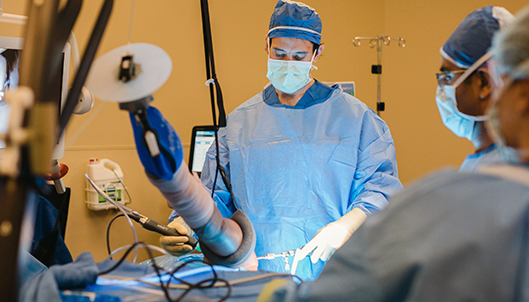
Femeroacetabular Impingment, often referred to as FAI for short, refers to a condition where there is a abnormality of the shape of the bones of the hip joint.
FAI can include an abnormality of the femur, bone in the thigh, where it is shaped like a ball (Femoral Head), or FAI can include an abnormality of the pelvic bone where it is shaped like a socket (Acetabulum). In some scenarios, there may be abnormalties of both the femoral head and acetabulum. A pincer lesion is an anatomic abnormality of the acetabulum where there is too much bone covering the femoral head. The pincer lesion may cause impingement at the hip with certain hip motions. With time and repetition, impingement at the hip can lead to degeneration of the acetabular labrum and cartilage within the hip joint. A surgical treatment for pincer impingement is acetabuloplasty, where the bone causing the impingment is shaved with a burr.
Before Dr. Anz will recommend surgery for hip impingement, he will first try non-operative measures consisting of rest, activity modification, and physical therapy to strengthen the core musculature and muscles around the hip. Injections into the hip may also be used for diagnostic and therapeutic purposes. If a patient continues to have ongoing hip pain, acetabuloplasty surgery for hip impingement may be recommended. The goal of an acetabuloplasty is to correct the bony conflict by removing excess bone . Often this procedure will be coupled with measures to address any labral or cartilage damage that may also exist.

During this procedure, Dr. Anz will use an arthroscopic surgical approach using two to three keyhole incisions. A camera (known as an arthroscope) is inserted into the hip to visualize the excess bone while the other incision is used to insert instruments to remove the excess bone. Often an arthroscopic burr is used to accomplish this. Hip acetabuloplasty entails taking away the area of over coverage on the acetabular side to relieve the bony impingement and create space allowing normal motion.
Following acetabuloplasty surgery for hip impingement, a thorough physical therapy program will be prescribed. This will include a progressive week-by-week plan that will work to restore motion of the hip while protecting repairs. Patients are typically on crutches for four weeks and placed in a brace to protect their hip during healing.
—
For more information on FAI impingement of the hip, pincer impingement of the hip, or for additional resources on treatments acetabuloplasty and arthroscopic hip surgery, please contact the office of Dr. Adam Anz, orthopedic hip surgeon in Gulf Breeze, FL.
